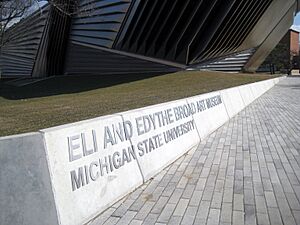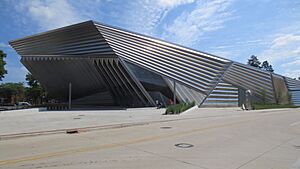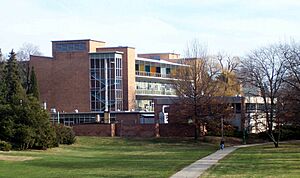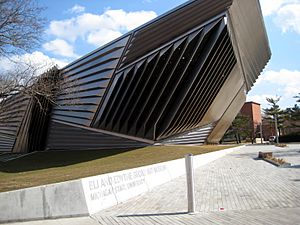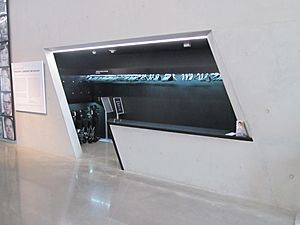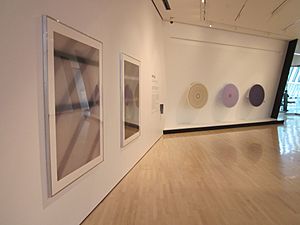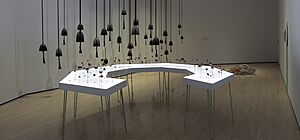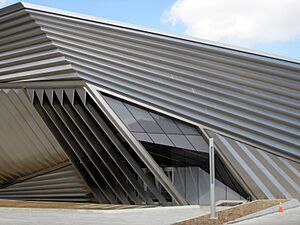Eli and Edythe Broad Art Museum facts for kids
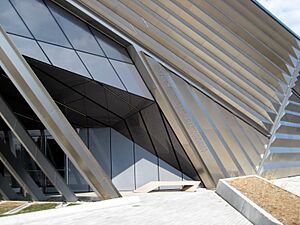
East entrance of the MSU Broad
|
|
| Established | November 2012 |
|---|---|
| Location | 547 East Circle Drive, East Lansing, Michigan |
| Type | Contemporary Art Museum |
| Collection size | 10,000+ |
| Visitors | 63,257 (2018); 48,500 (2021) |
| Nearest parking | MSU campus parking lots 7 & 8 and the Grand River parking structure |
The Eli and Edythe Broad Art Museum, also known as MSU Broad or BAM, is a special museum. It focuses on contemporary art, which means art from our time. The museum is located at Michigan State University in East Lansing, Michigan. It first opened its doors on November 10, 2012.
The museum often changes its art displays. This means there are always new and exciting shows to see. The MSU Broad focuses on artists from all over the world. Many of these artists are just starting their careers. The museum also shows art from its own large collection.
The MSU Broad offers many free programs for people of all ages. You can visit the galleries and attend community events for free. Sometimes, special exhibitions might have a small fee.
The museum is named after Eli Broad and Edythe Broad. They gave a very generous gift to help start the museum. The museum has a huge collection of over 10,000 art pieces. Many of these came from the old Kresge Art Museum. This collection includes art from ancient times to today. It features art from different cultures and in many styles.
You can see ancient Greek and Roman items there. There are also sculptures from before Columbus arrived in America. The museum has old paintings and modern sculptures too. Artists like Alexander Calder and Jenny Holzer have works there. The museum is always adding new art. It especially looks for art by artists of color, women artists, and other groups. These groups were not always shown much in art history.
The MSU Broad Art Museum was even used for filming! Parts of the movie Batman v Superman: Dawn of Justice were filmed there in October 2014.
Contents
Amazing Architecture and Design
A Unique Look
The Broad Art Museum has a very unique design. It was created by a famous architect named Zaha Hadid. The building is made of steel and concrete. Its outside walls are covered in shiny, folded stainless steel and glass. This gives the museum a cool, pleated look.
The museum has strong steel frames and concrete walls. The floors inside are polished concrete and wood. The outside walls are like a special shield. They are made of steel frames covered with the folded steel panels. The windows, doors, and skylights are designed to be very energy efficient.
Inside the Museum
About 70% of the museum's space is used for showing art. This includes special areas like the Education Wing. The museum has three levels: a lower level, a main ground level, and a second level. The tallest part of the museum is about 38 feet high.
The museum's design helps people move easily through the spaces. A large, floating staircase is at the center. The art galleries branch out from this staircase. From the second floor, you can see great views of the university campus and downtown East Lansing.
Outside, there is a sculpture garden. This garden is an extension of the east entrance. There is also a plaza at the west entrance. The museum also has offices and a gift shop.
Connecting with the Community
The Broad's design was made with the community in mind. The art galleries and public areas are set up to connect the city, its people, and the art. The museum creates a link between the university campus and downtown East Lansing. It has doors that open to both areas.
The large, two-story window near the floating staircase also connects the inside with the outside. All the openings in the building's unique exterior walls help link the museum with its surroundings. This allows visitors to feel connected to the city and campus.
Museum History
The Kresge Art Museum
Before the MSU Broad, Michigan State University had another art museum. It was called the Kresge Art Museum. This museum was located inside the university's art department building. The Kresge Art Museum started displaying art in the 1930s. In 1959, a special space called "the Gallery" was set aside for art. This became the Kresge Art Museum in 1984.
When the Eli and Edythe Broad Art Museum was finished, the Kresge Art Museum closed. Thousands of art pieces from the Kresge collection were put into storage. Many of these pieces were not shown again until November 2023. That's when the MSU Broad opened its Center for Object Research and Engagement (The CORE).
How the Museum Began
In 1999, a group called "Better Art Museum" was formed. Their goal was to create a new, larger museum.
On June 1, 2007, Michigan State University announced a huge gift. Eli Broad and his wife, Edythe Broad, donated $26 million. This was the largest gift the university had ever received at that time. Most of the money, $18.5 million, was for building the new museum. The rest, $7.5 million, was for buying new art and helping with museum operations.
The university decided to build the museum where an old building, the Paolucci Building, once stood. This building was taken down in 2008 to make space for the new museum.
Choosing the Design
The museum's design was chosen through a special competition. Many architectural firms submitted their ideas. Five firms were chosen as finalists. These included famous names like Zaha Hadid.
On January 15, 2008, it was announced that Zaha Hadid had won the competition. Her unique design was chosen for the new museum. The total cost of the project was about $40–$45 million. The Broads gave more gifts, bringing their total contribution to $33 million.
Building and Opening
Construction on the museum started on March 16, 2010. Eli Broad and Zaha Hadid attended the groundbreaking ceremony. The museum officially opened on November 10, 2012. Over 2,000 people came to the dedication ceremony. The next day, more than 3,000 visitors explored the new museum. In total, 6,000 people visited during the three-day opening event.
The construction company used special building methods. This was needed because of the museum's unique and complex design. The museum also earned a "LEED Silver" certification. This means it was built using environmentally friendly methods.
The museum's angular outside walls are made of pleated stainless steel and glass. Zaha Hadid Architects said this design makes the building look "ever-changing." It makes people curious but never fully reveals what's inside.
Focusing on the Community
When the Broad Art Museum first opened, people hoped it would bring many tourists. An early study predicted it would attract over 125,000 visitors each year. It was also expected to bring a lot of new money to the area.
Attendance was highest in 2013, with 98,000 visitors. However, the museum's economic impact was not as big as expected. Now, the museum is focusing more on the university community. It aims to connect more with students and local residents. The museum wants to be a place that serves the people right around it.
See also
 In Spanish: Museo de Arte Eli y Edythe Broad para niños
In Spanish: Museo de Arte Eli y Edythe Broad para niños


